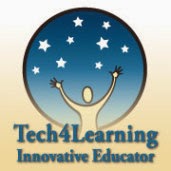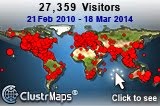Monday, March 28, 2011
Portfolios-- A "Digital Can of Worms?"
Tuesday, March 22, 2011
My Life as a Reader
 A few years ago, my father presented me with a very special gift. He had searched painstakingly, calling a number of used bookstores, to find a copy of The Big Tidy Up, the first book I ever "read" all by myself.
A few years ago, my father presented me with a very special gift. He had searched painstakingly, calling a number of used bookstores, to find a copy of The Big Tidy Up, the first book I ever "read" all by myself. Friday, March 18, 2011
Bats from A to Z
by Mrs. B's 2nd grade
It all started with a story. We read "Fast Food on the Fly," a story about bats, in our Wordly Wise book. We were so interested that we decided to write reports about different kinds of bats. We each chose our own bat, and they were all from Australia. We used the computers to research our bats, and we made a bat cave in the hallway where we displayed our reports.
We decided to create an ABC video to give people information about bats. Mrs. B and Ms. H showed us an example. Then we took a bat quiz. Next, we worked with a partner to brainstorm ideas using the alphabet organizer. We printed out the organizers with all of our ideas. Some letters were easier than others so we had to do more research to come up with a fact for each letter.
Once we decided the best fact for each letter and assigned the letters we used Pixie to write and illustrate our ideas. We went over them and checked to make sure they were correct and looked good. Then we recorded ourselves reading our facts. Finally, we published our video, and we are so excited to share it with you!
Some Reflections:
Ayden: We met our goal by finishing the video and teaching everyone about bats. I learned facts about bats that a lot of grown-ups don't know.
Elad: I did this before when we did the values report because I had to look in a book. I can use this again when I do another report or project.
Eliana: It was important that we taught people new information about bats. I learned to work together without arguing.
Griff: I see a relationship with this project and the president reports because we had to research on the computer for both. In both of them we were teaching people. I feel that I learned a lot about bats. I see that there is so much I didn't know about bats.
Jona: Our class did really well. We edited and revised it. We had to take our time in order to make it really good. We used the computer and used typing skills. I learned more about bats and I liked using technology.
Natan: We worked well together.
Mrs. B: I was very pleased to see the growth from our very first project, the fire safety and prevention video, to this project. I think you are going to be very prepared for 3rd grade.
Wednesday, March 16, 2011
Dear Thinkquest
Dear ThinkQuest Coach,
We noticed you enrolled in the ThinkQuest International Competition 2011, but have not yet enrolled any teams.
Enrolling a team is easy! Just follow these steps:
- Log in to your ThinkQuest account.
- Click the "Competition" tab.
- Click the "Enroll a Team" button.
- You can come back and edit your team later if any information changes.
As a bonus, you will be entered in the Coach Sweepstakes when you enroll your first team. Each month, one lucky coach will receive an Apple® iPad™ 16GB.
For additional assistance with team enrollment, visit Online Help.
Kind regards,
Oracle Education Foundation
Um... thank you for your concern and offer of additional assistance? Really?
Sunday, March 6, 2011
The Flat Classroom- Are We Really Ready?
Interestingly, we discovered that Muslim and Jewish beliefs are very similar in certainways. We both have certain times to pray, traditional articles of clothing, forbidden foods, as well as so much more.
It is important to learn about other religions, to realize the similarities between all cultures around the world. We have to set aside our differences and look at the ways that we are all alike... Hopefully, one friendly interaction at a time, more and more people will begin to realize the similarities connecting people around the world.
Today we watched the "reaction to the lunches" video from the school in ___, where they showed every slide except for the one we uploaded, which had some writing in Hebrew. What is the point of doing a "global awareness" project if not to promote tolerance, acceptance and eventually to teach the next generation that things like hatred and anti-semitism must be overcome?...I feel that no school in the project should be allowed to simply ignore another school because of language or culture. I am really upset by this... How do you teach 9-10 year olds that people in the world hate Jews so much that the adults will not allow the children to look at a slide that has Hebrew writing on it?
I do believe that we are really one world and one heart, no matter where we come from or what our religion is...We can't make any relation with Israel no matter what the relation is. It will be dangerous for me and for my family...I feel sorry not being able to communicate with her...but this is the situation in our country.
When I made up those clusters I had no idea that having your two schools together would be a problem. When ___first emailed me I immediately thought that I should have been more aware and perhaps not put your two schools in the same group to begin with which is why I was so quick to change the groups...it is not a situation I am very familiar with...
Given the political climate in ______, this teacher may be justifiably fearful (as I’m sure that there would have been German teachers in the 30s). That being said, if the [project] folk can rationalize the discrimination (after all, this is not our school issuing Israeli political propaganda, but simply existing and being itself), it does quite the opposite of promoting co-existence. Participants in______ can’t have it both ways – global understanding . . . except for those whose right to exist we won’t acknowledge.








